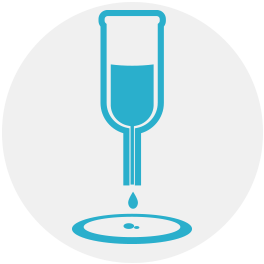Radioactive source preparation / radiochemistry

The first condition for carrying out good measurements in the field of radioactivity is the availability of radioactive sources adapted to the measuring equipment and representative of the samples to be characterized.
The preparation of these sources therefore requires the development and implementation of techniques involving radiochemistry, analytical chemistry, weighing, etc.
Within this framework, the LNHB participates in different projects and conducts studies on different themes:
- For example, as part of the European MetroMRT (Metrology for molecular radiotherapy) project dedicated to vectorized radiotherapy, the LNHB conducted a study on yttrium 90 microspheres for the treatment of liver cancers. Injected into the hepatic artery, the product acts by radio-embolization of the tumour.
In order to establish the metrological traceability of this product in terms of activity, it was first necessary to develop a technique for rapid and complete dissolution of resin microspheres inside the bottle supplied by the manufacturer. The activity of the solution thus obtained could be measured optimally, using a primary method adapted to both the radionuclide (yttrium 90) and its conditioning (aqueous solution). - Another study deals with the preparation and characterization in terms of mass or volume activity of spiked matrices for environmental activity measurements, traceable to LNHB national standards.
Laboratories belonging to the National Network of Environmental Radioactivity Measurements are subject to control and certification procedures set up by the French Nuclear Safety Authority (ASN). The authorizations issued by the ASN require the laboratories to pass the proficiency tests organized by the Institute of Radiation Protection and Nuclear Safety (IRSN) with a maximum validity of five years. All types of matrices present in the environment can be covered (water, soil, biological matrices, aerosols, gases). In these fields, laboratories can often only be traceable to national standards in a very indirect way: for example, by making their own standards by incorporating commercial standard solutions into their real matrices.
In order to improve the traceability of measurements, the LNHB has initiated a project to develop better adapted metrological references, notably by using spiked real matrices. The laboratory will thus be able to complete the range of services it has been offering to laboratories for the measurement of radioactivity for more than 45 years, as part of its annual Interlaboratory Proficiency Tests Programme (PTI).
EXAMPLE OF COLLABORATIVE PROJECTS:
European Metrology Project EMPIR: Dosimetry for molecular radiotherapy
Link to the website: projects.npl.co.uk/metromrt
Link to the final report of the MetroMRT project: http://projects.npl.co.uk/metromrt/news-events/metromrt-final-publishable-jrp-report-draft.pdf
REFERENCES:
– V. Lourenço, C. Bobin, V. Chisté, D. Lacour, F. Rigoulay, M. Tapner, C. Thiam, L. Ferreux, Primary standardization of SIR-Spheres based on the dissolution of the 90Y-labeled resin microspheres, Applied Radiation and Isotopes 97 (2015) 170–176,
http://dx.doi.org/10.1016/j.apradiso.2014.12.024
– V. Lourenço and C. Bobin, Weighing uncertainties in quantitative source preparation for radionuclide metrology, Metrologia, Volume 52, Number 3,
doi : 10.1088/0026-1394/52/3/S18
